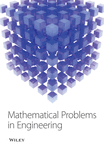Investigation of Atom-Bond Connectivity Indices of Line Graphs Using Subdivision Approach
Abstract
A topological index is a numerical measure that characterises the whole structure of a graph. Based on vertex degrees, the idea of an atom-bond connectivity (ABC) index was introduced in chemical graph theory. Later, different versions of the ABC index were created, and some of these indices were recently designed. In this paper, we present the edge version of the atom-bond connectivity (ABCe) index, edge version of the multiplicative atom-bond connectivity (ABCIIe) index, and atom-bond connectivity temperature (ABCT) index for the line graph of subdivision graph of tadpole graph (Tn,k), ladder graph (Ln), and wheel graph (Wn+1). Numerical simulation has also been shown for some novel families of atom-bond connectivity index comparing the three types of indices which can be useful for QSAR and QSPR studies.
1. Introduction
In this article, we have considered simple graphs, which are unweighted, undirected graphs that have no loops and multiple edges attached. Let G be a simple graph, with vertex set V(G) and edge set E(G). Suppose e is an edge of G, which connects the vertices u and v, then we denote e = uv and state that “u and v are adjacent.” The degree du of a vertex u is the number of edges that are incident to it. Topological indices are the mathematical measures that correspond to the structure of any simple finite graph. They are invariant under the graph isomorphism. There are some famous degree-based topological indices, which are introduced and applied in chemical engineering, for instance, the Randic index (refer to Ali & Du [1], Li & Shi [2], and Shi [3] for more details). These indices are also significant in quantitative structure-property relationship (QSPR) and quantitative structure-activity relationship (QSAR) (see [4, 5]).
2. Main Results
In 2011, Ranjini et al. calculated the explicit expression for the Shultz indices of the subdivision graphs of the tadpole, wheel, helm, and ladder graphs [25]. They also studied the Zagreb indices of line graphs of tadpole, wheel, and ladder graphs with subdivision in [26]. In 2015, Su & Xu calculated the general sum-connectivity indices and coindices of line graphs of tadpole, wheel, and ladder graphs with subdivision in [27]. In [28], Nadeem et al. computed ABC4 and GA5 indices of the line graphs of these graphs by using the notion of subdivision. They also studied the ABC4 and GA5 of these graphs [28]. Other studies on these include Rajasekar & Nagarajan [29] research on the location domination number of the line graph. Recently, Li &. Taylor [30] also studied the first Zagreb index and some Hamilton properties of the line graph.
A tadpole graph Tn,k is the graph obtained by joining a cycle of n vertices with a path of length k. A ladder Ln is obtained by taking the Cartesian product of two paths Pn × P2. A wheel graph Wn or order n composed of a vertex is called the hub, adjacent to all vertices of a cycle of the order n.
Motivated by the results of [26, 27, 31], we studied the line graph of the subdivision graph Tn,k, Ln, and Wn+1 and derived an expression for the edge version of atom-bond connectivity, multiplicative atom-bond connectivity indices, and atom-bond connectivity temperature index of the graphs L(S(Tn,k)), L(S(Wn+1)), and L(S(Ln)).
Theorem 1. The edge version of the atom-bond connectivity index of L(S(Tn,k)) is
Proof. Let G be the line graph of the subdivision graph L(S(Tn,k)), seeing Figure 1. It contained 2(n + k) edges of the subdivision graph of S(Tn,k), and then, in the graph of G, it contained 2(n + k) vertices. It consists of three types of degree of edge e, such as 1, 2, and 3. Out of which, 3 vertices are of the degree 3, one vertex of degree 1 and the remaining 2(n + k − 2) vertices are of the degree 2. The graph of G contains path of length 2k − 1. Let V1 be the vertex of degree 3 which is attached to this path. Let and be the neighbor of V1 which are of degree 3 in the L(G). The vertices and have two neighbors of degree 3 and one neighbor of degree 2 in L(S(Cn) + e), where e is the edge adjacent to S(Cn). The vertex V1 has 2 adjacent vertices of degree 3 and one vertex of degree 2 in the path. Let we derive an expression for the edge version of topological indices of the graph G, for k = 1. In graph G, it contains a path of length 1 which attached with V1. Hence, with respect to the path is . For corresponding to the vertices V1, in L(S(Cn) + e), hence, we have . Since one edge in G is shared between pairs of vertices, . Among the remaining, 2n − 4 vertices, for 2n − 5 vertices, have neighbors of degree 2, and one vertex has neighbor of degree 3. Hence, with respect to 2n − 4 vertices is . Adding all these number together, the edge version of atom-bond connectivity index of G is found as .
If k > 1, then the graph G contains path of length 2k − 1 which attached with V1. Hence, with respect to the path is . For corresponding to the vertices V1, in L(S(Cn) + e), hence, we have . Since one edge in G is shared between pairs of vertices, . Out of 2n − 2 vertices, for 2n − 3 vertices have neighbors of degree 2 and one vertex has neighbor of degree 3. Hence, with respect to 2n − 2 vertices is . Adding all these number together, the edge version of atom-bond connectivity index of G is found as . This completes the proof.
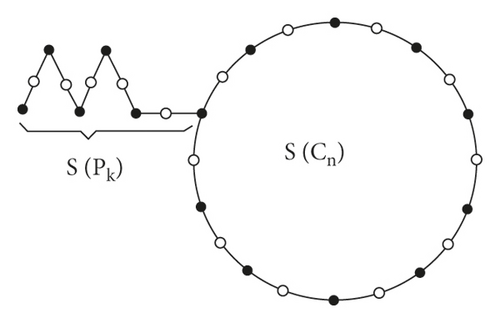
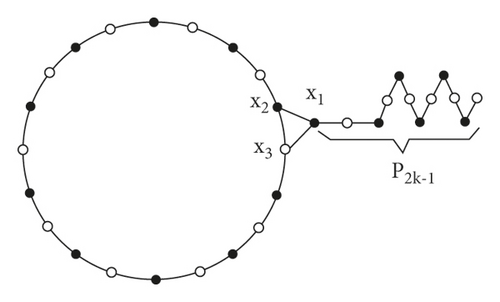
Theorem 2. The edge version of the multiplicative atom-bond connectivity index of L(S(Tn,k)) is
Proof. After adopting the induction method, it is clear that overall speaking, this line graph of subdivision graph possesses of 2(n + k) vertices and 2(n + k) + 1 edges. If de and df are the degree of edge e, then there are 1 edge of type de = 1, df = 3, 2n − 5 edges with de = df = 2, 2 edges of type de = 2, df = 3, 3 edges with de = df = 3. Hence, for graph G with k = 1, we have . For k > 1, we have 1 edge of type de = 1, df = 2, 2n + 2k − 6 edges with de = df = 2, 3 edges of type de = 2, df = 3, 3 edges with de = df = 3. Hence, we deduce
This completes the proof.
Theorem 3. The atom-bond connectivity temperature index of L(S(Tn,k)) is
Proof. In G, there are total 2(n + k) vertices, among which 3 vertices are of the degree 3, one vertex of degree 1 and the remaining 2(n + k − 2) vertices are of the degree 2. The total number of edges of G is 2(n + k) + 1. For k = 1, we have 2(n + 1) vertices, which one vertex of degree 1, 3 vertices of degree 3 and 2(n − 1) vertices of degree 2. Therefore, after adopting the induction trick, we have 4 edge partition based on the temperature. If Tu and Tv are the temperature of the vertex u and v, then there are 1 edge of type T1 = 1/2n + 1, T3 = 3/2n − 1, 2n − 5 edges with T2 = T2 = 1/n, 2 edges of type T2 = 1/n, T3 = 3/2n − 1, 3 edges with T3 = T3 = 3/2n − 1. Hence, for graph G with k = 1, we have
For k > 1, we have 1 edge of type T1 = 1/2n + 2k − 1, T2 = 2/2n + 2k − 2, 2n + 2k − 6 edges with T2 = T2 = 2/2n + 2k − 2, 3 edges of type T2 = 2/2n + 2k − 2, T3 = 3/2n + 2k − 3, 3 edges with T3 = T3 = 3/2n + 2k − 3. Therefore, we get
This completes the proof.
Theorem 4. The edge version of the atom-bond connectivity index of L(S(Wn+1)) is
Proof. Let G be the line graph of the subdivision graph L(S(Tn,k)), seeing Figure 2. It contains 4n vertices are of degree 3 and n vertices of degree n. Out of n2 + 9n/2 edges, the 4n edges of degree 3 have neighbor of degree 3. Hence, corresponding to these 4n edges which have only neighbor of degree 3 is 8n/3. The remaining n vertices of degree 3 are adjacent to vertices of degree n. Hence, with respect to these n vertices is . Also remaining n(n-1)/2 edges of degree n have neighbor of degree n. Hence, with respect to all these degrees of n is . Adding all these number together, the edge version of atom-bond connectivity index of G is found as . This completes the proof.
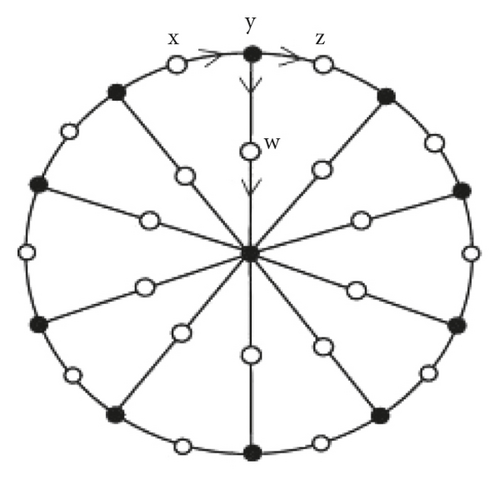
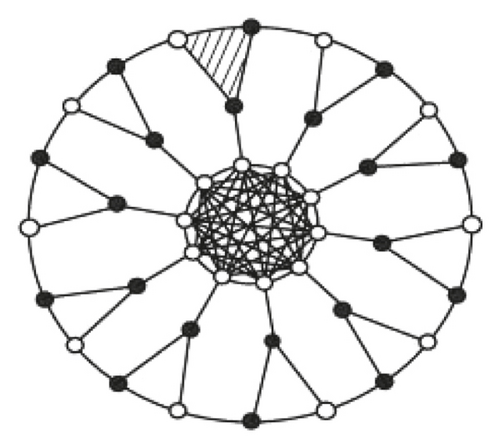
Theorem 5. The edge version of the multiplicative atom-bond connectivity index of L(S(Wn+1)) is
Proof. After adopting the induction technology, it is clear to find that, roughly speaking, this line graph of subdivision graph has contained 4n vertices and n2 + 9n/2 edges. Also, there are 4n edges of type de = df = 3, n edges of type de = 3, df = n, n(n − 1)/2 edges with de = df = n. As a result, we infer
This completes the proof.
Theorem 6. The atom-bond connectivity temperature index of L(S(Wn+1)) is
Proof. In G, there are total 4n vertices are of degree 3 and n vertices of degree n. The total number of edges of G is n2 + 9n/2. After adopting the induction method, we have 3 edge partition based on the temperature. If Tu and Tv are the temperature of the vertex u and v, then there are 4n edge of type T3 = T3 = 3/4n − 3, n edges with T3 = 3/4n − 3, Tn = 1/3 and n(n − 1)/2 edges of type Tn = Tn = 1/3. Hence, we deduce
This completes the proof.
Theorem 7. The edge version of the atom-bond connectivity index of L(S(Ln)) is
Proof. Let G be the line graph of subdivision graph L(S(Ln)), seeing Figure 3. The number of vertices in G is 6n − 4 among which 8 vertices are of degree 2 and the remaining 6n − 12 vertices are of degree 3. The number of edges in G is 9n − 10 among which 6 edges are of degree 2 with itself, 4 edges are of degree 2 and 3, and the remaining 9n − 20 edges are of degree 3 with itself. Adding all these numbers together, the edge version of the atom-bond connectivity index of G is found as . This completes the proof.
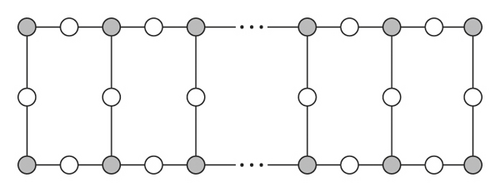
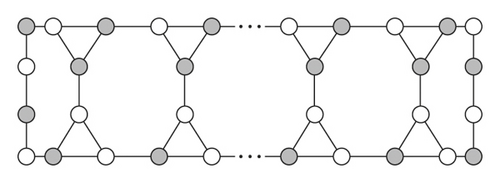
Theorem 8. The edge version of multiplicative atom-bond connectivity index of L(S(Ln)) is
Proof. After adopting the induction trick, we can find that, in general, this line graph of subdivision graph has 6n − 4 vertices and 9n − 10 edges. At the same, there are 6 edges of type de = df = 2, 4 edges of type de = 2, df = 3, 9n − 20 edges with de = df = 3. Therefore, we get
This completes the proof.
Theorem 9. The atom-bond connectivity temperature index of L(S(Ln)) is
Proof. In G, there are total 6n − 4 vertices in which 8 vertices are of degree 2 and the remaining 6n − 12 vertices are of degree 3. The total number of edges of G is 9n − 10. After adopting the induction technology, we have 3 edge partition based on the temperature. If Tu and Tv are the temperature of the vertex u and v, then there are 6 edge of type T2 = T2 = 1/3n − 3, 4 edges with T2 = 1/3n − 3, T3 = 3/6n − 7 and 9n − 20 edges of type T3 = T3 = 3/6n − 7. As a result, we infer
This completes the proof.
3. Numerical Simulation and Conclusion
In this paper, we propose some novel families of atom-bond connectivity index. Now, the results of these indices will be compared. The comparison between ABCe, ABCIIe, and ABCT of L(S(Tn,k)) is shown in Table 1. The graphical representation of Table 1 is illustrated in Figure 4.
| (n, k) | ABCe | ABCIIe | ABCT |
|---|---|---|---|
| (1, 1) | 2.1093898 | −4.898979486 | 4.7876937 |
| (2, 2) | 6.242640687 | 4.242640687 | 23.98539667 |
| (3, 3) | 9.071067812 | 12.72792206 | 72.10624376 |
| (4, 4) | 11.89949494 | 21.21320344 | 142.5586461 |
| (5, 5) | 14.72792206 | 29.69848481 | 235.5731609 |
| (6, 6) | 17.55634919 | 38.18376618 | 351.1898721 |
| (7, 7) | 20.38477631 | 46.66904756 | 489.4215973 |
| (8, 8) | 23.21320344 | 55.15432893 | 650.2737199 |
| (9, 9) | 26.04163056 | 63.63961031 | 833.7488996 |
| (10, 10) | 28.87005769 | 72.12489168 | 1039.848602 |
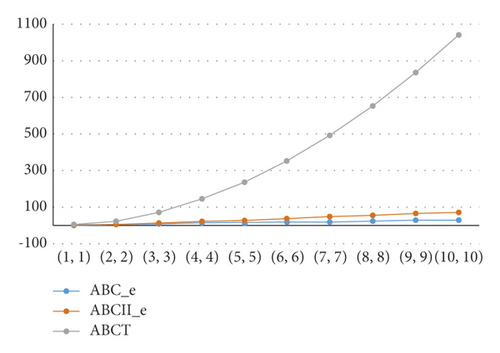
Similarly, the results for ABCe, ABCIIe, and ABCT of LS(Wn+1) are compared in Table 2. Table 2 is given in Figure 5. Finally, the comparison of ABCe, ABCIIe, and ABCT of L(S(Ln)) is shown in Table 3. The illustration of the results for ABCe, ABCIIe, and ABCT is shown as Figure 6.
| n | ABCe | ABCIIe | ABCT |
|---|---|---|---|
| 1 | 3.483163248 | 0 | 3.821367205 |
| 2 | 7.454653677 | 5.333333333 | 20.00859965 |
| 3 | 12 | 32 | 62.35382907 |
| 4 | 16.92289018 | 101.1928851 | 124.0640009 |
| 5 | 22.15246524 | 238.5139176 | 205.2566258 |
| 6 | 27.64735154 | 473.2863826 | 305.8662831 |
| 7 | 33.37946531 | 838.1312546 | 425.8255499 |
| 8 | 39.32811367 | 1368.662608 | 565.0772788 |
| 9 | 45.47722558 | 2103.254621 | 723.5738722 |
| 10 | 51.81385047 | 3082.855819 | 901.2753388 |

| n | ABCe | ABCIIe | ABCT |
|---|---|---|---|
| 1 | −0.2622655215 | −88 | −8.061498381 |
| 2 | 5.737734479 | −16 | 27.04079003 |
| 3 | 11.73773448 | 56 | 100.868826 |
| 4 | 17.73773448 | 128 | 225.7405179 |
| 5 | 23.73773448 | 200 | 401.5280011 |
| 6 | 29.73773448 | 272 | 628.2266894 |
| 7 | 35.73773448 | 344 | 905.8363724 |
| 8 | 41.73773448 | 416 | 1234.357204 |
| 9 | 47.73773448 | 488 | 1613.789329 |
| 10 | 53.73773448 | 560 | 2044.132853 |
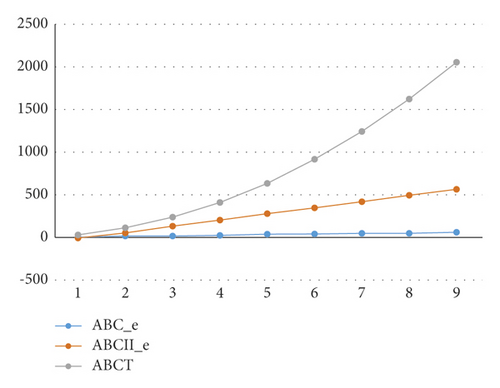
In this paper, certain degree-based topological indices, namely, ABC indices, were studied for the case of the line graphs of the subdivision graphs. It is anticipated that this computational study will encourage the researchers to have a firm grasp on the index framework they have chosen. The computational technique presented here can be useful for analysing the physicochemical features of the specified network, as well as being cost-effective and time-efficient. Future work includes the investigation of new classes of line graph of subdivision graphs and their topological indices which is useful in QSAR and QSPR studies.
Conflicts of Interest
The authors declare that they have no conflicts of interest.
Acknowledgments
The authors acknowledge Universiti Malaysia Terengganu for providing the financial support under Talent and Publication Enhancement-Research Grant (TAPE-RG; vot no. 55330).
Open Research
Data Availability
All data required for this paper are included within these papers.



